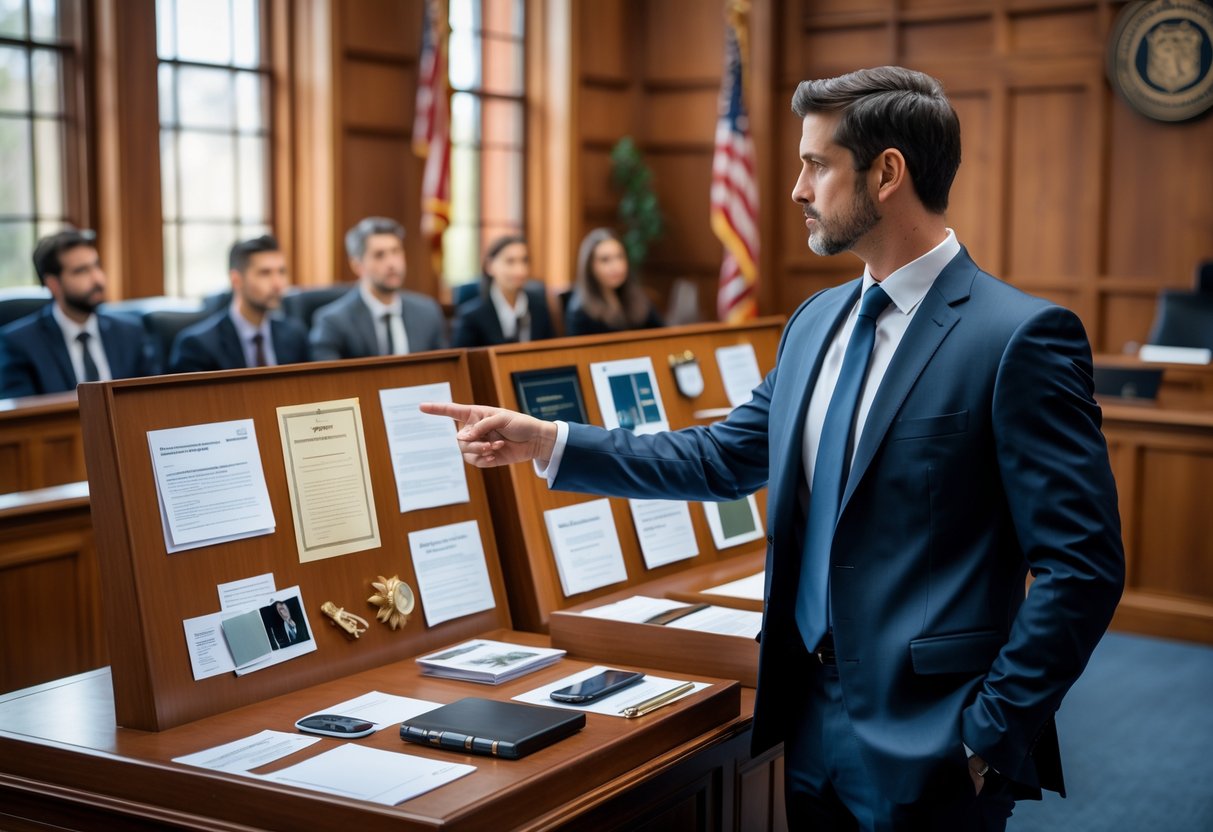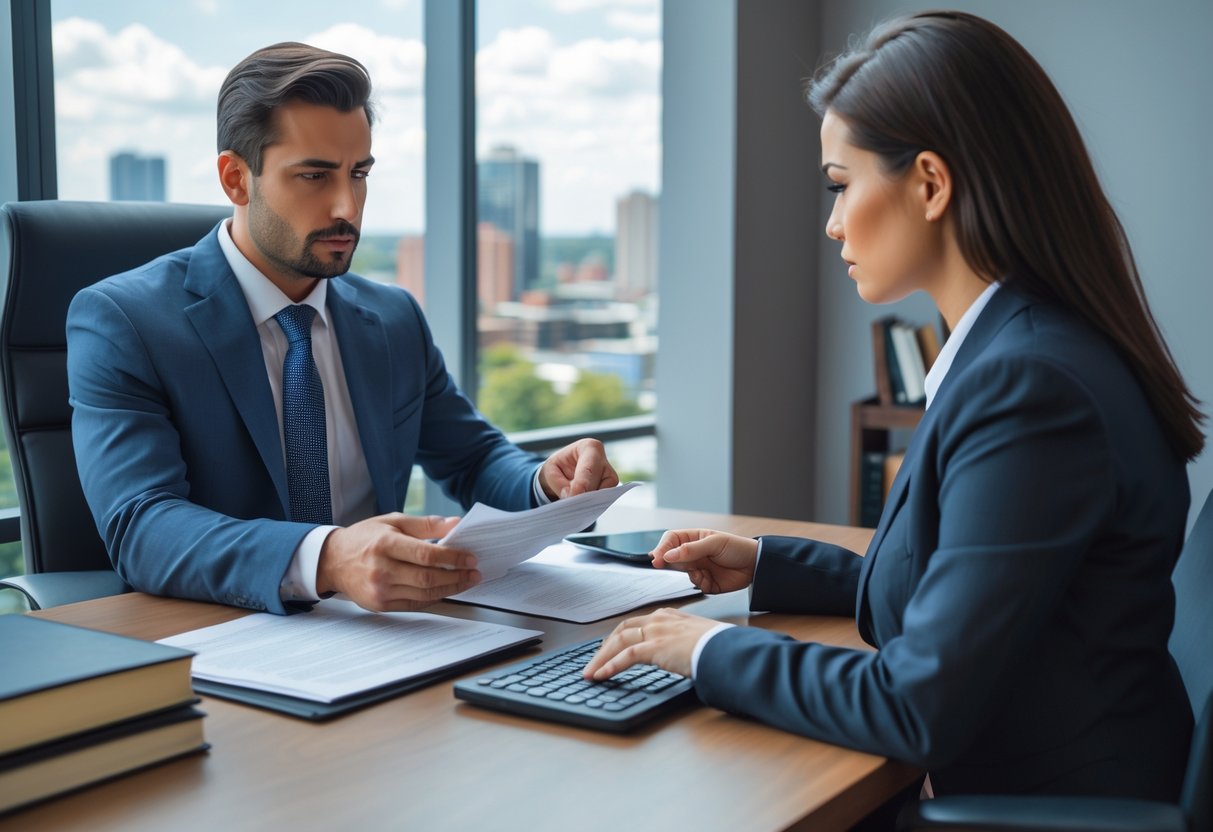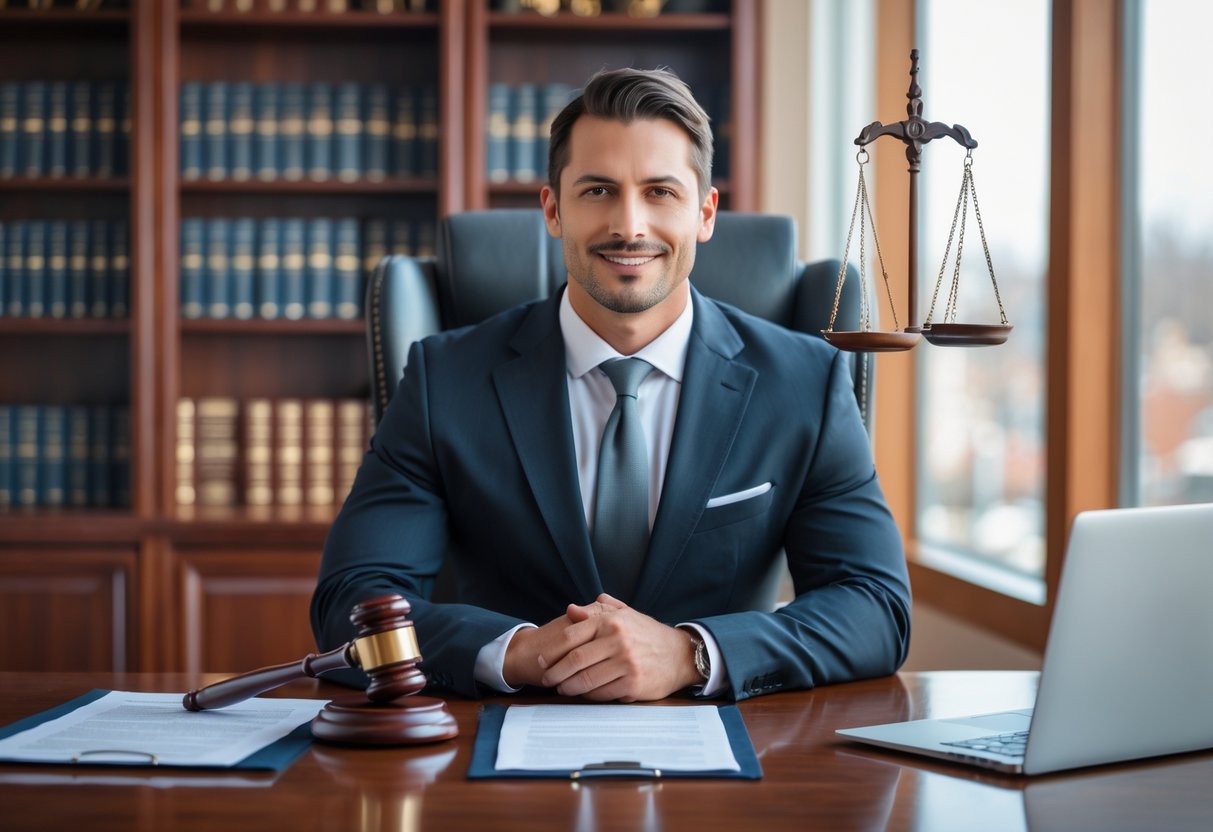When we think about a trial, what matters most is how evidence is shown and explained. Clear and fair evidence presentation helps judges and juries understand the facts, which is key to making the right decision. If evidence is confusing or misleading, it can mean the difference between justice and a mistake.

We rely on strong evidence to support our side and to question claims from the other side. In the judicial process, the way we share and challenge evidence can decide the outcome of the case.
Understanding the importance of evidence in trial gives us better insight into how the courts work and why following the rules of evidence matters for everyone involved.
Fundamentals of Evidence Presentation in Trial
Evidence presentation is a structured process that helps judges and juries make informed decisions in court. It depends on following rules and procedures to make sure information is clear, reliable, and fair to both sides.
Defining Evidence Presentation
Evidence presentation means showing proof and information during trial to support a legal argument. This can include documents, objects, witness testimony, photographs, and videos. Each type of evidence must follow certain legal rules before it is shown in court.
When we talk about “presenting evidence,” we are referring to how lawyers introduce and show the evidence to the judge or jury. This includes explaining its purpose and how it supports their case. The goal is always to show the truth and give each side a chance to explain their version of events.
Proper presentation makes it easier for the court to understand the facts. If rules are not followed, evidence may be left out, which can affect the fairness of the trial.
Role of Evidence in the Judicial Process
Evidence is at the center of any trial. It allows us to prove or disprove claims and make sure that decisions are based on facts instead of opinions or guesses. Without evidence, it would be nearly impossible for judges or juries to know what really happened.
There are many types of evidence, such as:
- Direct evidence (like an eyewitness account)
- Physical evidence (like fingerprints or weapons)
- Documentary evidence (like letters or contracts)
- Expert testimony (like a doctor’s explanation)
Each type has its own rules and impact on a case. Admitting the right evidence and explaining it well can mean the difference between winning or losing a case.
Establishing Facts Through Evidence
During trial, we use evidence to establish which facts are true and which are not. Courts rely on the evidence the parties present to build a clear picture of the case. The evidence must be both relevant (related to the case) and reliable (trustworthy and accurate).
We introduce evidence step-by-step. First, we collect and organize it, then present it following procedures. The judge decides whether the evidence can be shown to the jury. When accepted, evidence becomes part of the case record.
Having strong, clear evidence helps us prove our points. Poor or weak evidence can fail, making it harder to support our case or defend against claims.
Types of Evidence and Their Significance

We use several kinds of evidence in trials to help judges and juries decide what really happened. Each type is important for different reasons and has its own rules about how it can be shown and trusted in court.
Testimonial Evidence in Court
Testimonial evidence comes from what people say in court. This includes witness testimony, where witnesses tell the court what they saw, heard, or know about the case. Witnesses promise to tell the truth before giving their testimony.
We rely on witness testimonies because they can provide details that other evidence might not show. Sometimes, the credibility of a witness is questioned to test how reliable their story is. For example:
- Eyewitnesses may identify a suspect.
- Expert witnesses explain technical facts, like DNA results.
Questions from lawyers help clarify and test what each witness says. The trustworthiness of testimonial evidence often depends on the witness’s memory and honesty.
Documentary Evidence and Authentication
Documentary evidence includes papers, emails, contracts, receipts, and other documents. We use this type to prove facts, like a business agreement or bank record. Before we can use a document as evidence, we must prove it is real and unchanged; this is called authentication.
Authentication may involve testimony from someone who saw the document made or handled it. In some cases, we show where the document came from and how it was kept safe. If the document cannot be traced or appears fake, the judge may not allow it.
- Original documents are preferred.
- Copies may need extra proof that they match the original.
Physical and Demonstrative Evidence
Physical evidence is any real object, such as a weapon, piece of clothing, or broken glass. It helps link people to the crime scene or event. Demonstrative evidence includes models, maps, diagrams, or photos that show how something happened.
We use physical and demonstrative evidence to help the judge or jury see or understand important facts. For example, a fingerprint on a door can place someone at a location. A map can show the layout of a room or a route someone took.
It is essential to prove that the evidence is authentic and has not been changed. Keeping records, called chains of custody, helps show where the evidence has been at all times.
Digital Evidence in Modern Trials
Digital evidence comes from computers, phones, cameras, or the internet. Examples include text messages, emails, social media posts, or location data from GPS. We use digital evidence more often in modern trials because so much daily life happens online.
Police and lawyers must collect and handle digital evidence carefully to avoid claims that it was changed or tampered with. We often need experts to explain what the evidence shows and how it was found. Authenticity is a major concern, so digital files must be shown to be real and not edited.
- Digital evidence can come from many sources.
- Proper collection and storage of data is required.
- Experts may need to verify and explain the evidence.
Legal Standards Governing Evidence Presentation
In every trial, what evidence we can use depends on strict legal rules. These standards make sure that only fair and trustworthy evidence is shown to the jury or judge.
Rules of Evidence and Admissibility
The rules of evidence control what we can and cannot show at trial. They define admissibility, meaning whether evidence is allowed. For example, hearsay statements made outside of court are usually not allowed unless they meet an exception. Also, evidence must be relevant to the case and not confuse or mislead the jury.
We need to make sure that all evidence follows these standards. Important factors include whether the evidence is authentic, not prejudicial, and directly relates to the facts. If we fail to follow these rules, evidence can be excluded, which can strongly affect how the trial goes.
Federal Rules of Evidence
In the United States, the Federal Rules of Evidence set one common standard for all federal courts. These rules cover admissibility of evidence, including topics like:
- Relevance: Evidence must relate to the case issues.
- Hearsay: Most out-of-court statements are not allowed unless a listed exception applies.
- Authentication: Evidence must be shown to be genuine.
- Privileges: Certain information, like private talks with a lawyer, cannot be used.
Understanding these rules helps us make sure that what we present in court meets all federal standards. We often use checklists or quick reference tables to double-check our evidence, like:
| Rule | Main Requirement |
|---|---|
| Relevance | Must help prove or disprove a fact |
| Hearsay | Needs a clear exception |
| Authentication | Must show the evidence is real |
| Privileges | Certain information is protected |
Compliance With Evidentiary Rules
We must follow evidentiary rules closely to avoid problems. Judges can reject evidence if we do not follow the proper steps, or if our evidence breaks the rules. This can happen if we forget to lay the right foundation or try to use evidence that is too unfair.
Legal compliance is not just a rule it is necessary for a fair trial. Attorneys need to know how to object to improper evidence and defend the admissibility of their own. If evidence is not admitted because of mistakes, it could affect the outcome of the case.
We must always use the proper procedure. Checking every piece of evidence for compliance with admissibility standards is a part of careful trial preparation. This helps us give the judge and jury the facts they need, within the boundaries of the law.
Preparation and Organization of Evidence
Careful handling of evidence from the earliest stages protects its reliability in court. We focus on proper collection, clear organization, and strict records that help us meet legal standards and prove our points.
Thorough Pre-Trial Preparation
We begin by collecting all possible evidence well before the trial. This stage involves reviewing witness statements, securing documents, and gathering physical items connected to the case.
Early preparation lets us check for missing information or weak points. We consult experts if evidence requires technical analysis or special knowledge. This helps make sure our case is grounded in strong, reliable facts.
We must follow rules covering evidence law so nothing crucial gets left out or excluded. By preparing early, we reduce surprises and have time to fix mistakes. Careful preparation means we enter the courtroom ready and confident.
Organizing Evidence for Presentation
Organizing evidence is not just about making neat files. We group evidence by type, time, event, or person, using tables or charts for easy reference. For example:
| Exhibit Number | Description | Source | Witness |
|---|---|---|---|
| 1 | Email chain | Plaintiff’s PC | John Smith |
| 2 | Security video | Office cameras | Lisa Jones |
We label every piece clearly and make lists for quick access. Evidence is sequenced in the order it will be presented, matching our case outline.
Visual tools such as binders, spreadsheets, and color codes help us locate items quickly during stressful trial moments. This methodical approach shows the court that we are orderly, which boosts our credibility.
Maintaining Chain of Custody
Maintaining the chain of custody keeps the integrity of physical and digital evidence. It tracks who collected, handled, transferred, or stored each item from the scene to the courtroom.
We use logs, tags, and signatures to document every handoff and location change. Breaks in the chain could allow challenges that might lead to evidence being thrown out.
Chain of custody records should include:
- Date and time received
- Person handling the evidence
- Reason for transfer or storage
- Storage location
Following these practices helps us show the court that the evidence is original and unchanged. This is crucial for meeting rules of evidence law.
Effective Strategies for Presenting Evidence
Presenting evidence in a way that helps jurors remember and understand key facts can improve our case outcomes. Strong trial presentation techniques help us organize facts, highlight crucial details, and make difficult concepts more accessible.
Engaging the Jury With Visual Storytelling
We can make evidence easier to follow by using a clear story supported by visuals. When we build a timeline or map out the sequence of events, jurors can see how the facts come together. This clear structure helps jurors recall key moments and understand how each piece of evidence connects.
Example visual storytelling tools:
- Event timelines
- Sequence charts
- Graphic maps
The right story keeps jurors interested and focused. If we walk jurors step-by-step through the events, using diagrams or images to show changes over time or location, it’s less likely key facts will be missed. Visual storytelling works best when it is simple and directly related to the evidence itself.
Utilizing Demonstrative and Visual Aids
Visual aids, like photos, diagrams, and charts, help jurors interpret complex evidence. These aids highlight patterns and relationships that may not be clear from spoken testimony or written documents. We can use charts to compare financial figures, diagrams to explain accident scenes, or timelines to set out a series of events.
| Type of Visual Aid | Purpose | Example |
|---|---|---|
| Chart | Clarify comparisons | Bar graph of losses |
| Diagram | Show relationships | Crime scene sketch |
| Timeline | Sequence of events | Case chronology |
Demonstrative aids should always be clear, accurate, and easy for the jury to understand. Too much detail or poor design can confuse rather than clarify. Effective visual aids make our evidence presentation more engaging and memorable.
Leveraging Expert Testimony
Expert witnesses can explain technical or scientific evidence that is central to our case. When we use experts, they add authority to our presentation and help jurors grasp tough topics. It is important for our experts to speak plainly and to use examples or visual aids when possible.
Experts often support their points with demonstrative exhibits like samples, models, or animations. These help show cause-and-effect or provide a step-by-step breakdown of complicated details. Key strategies for working with expert testimony include preparing the expert to avoid jargon, focusing testimony on core facts, and making sure all exhibits are easy to understand.
We give jurors the tools they need to evaluate evidence by clearly explaining the expert’s area of knowledge and tying the testimony back to the big picture. This way, the jury can make informed decisions based on reliable information.
Legal Arguments and Advocacy Through Evidence
Presenting evidence plays a critical role in linking facts to legal arguments. We use evidence not only to support our case but also to advocate clearly and fairly while respecting the rules of court.
Supporting Legal Arguments With Evidence
We build our legal arguments by directly connecting the evidence to specific points of law. When we introduce a document, photograph, or witness statement, we do so to prove or disprove parts of our case.
For example, in a theft trial, showing video footage or eyewitness testimony links the person to the event. If we can back each argument with solid evidence, the judge or jury has a reason to trust our position.
Below are ways evidence supports legal arguments:
| Legal Argument | Supporting Evidence |
|---|---|
| Alibi defense | Phone records, receipts |
| Breach of contract | Emails, signed contracts |
| Self-defense | Medical reports, photos |
When we fail to connect facts to evidence, our arguments become weak. It’s important that every claim made in court relates to something concrete and easy to understand.
Persuasive Impact of Effective Communication
Advocacy depends on how we communicate facts, not just what those facts are. Evidence becomes more convincing when we explain it in plain language and guide the judge or jury through complex details.
Using simple charts, timelines, or real-life examples turns confusing data into something everyone can follow. For instance:
- Referring to a timeline helps break down when and how events happened.
- Showing side-by-side before-and-after photos illustrates damage or changes that matter to the case.
- Reading a key statement from a document draws attention to the most important part.
Clear presentations remove doubt and keep people interested. When we present evidence well, we make it easier for decision-makers to see the truth in our arguments.
Objectivity and Ethical Considerations
Presenting evidence comes with ethical responsibilities. As legal advocates, our job is to stay objective, even when we strongly support our own side. We must not twist the meaning of evidence or hide details that could be important.
Here are key ethical rules we follow:
- Disclose required evidence: Reveal both helpful and harmful facts, as required by law.
- Avoid misleading statements: Never change facts or misrepresent what evidence shows.
- Respect court rules: Follow all procedures for submitting and discussing evidence.
Maintaining objectivity builds trust with the court. We show respect for legal standards and help ensure that justice is done based on facts, not on bias.
Challenges and Compliance in Evidence Presentation
Evidence presentation can face practical and legal problems. We need to handle objections, respect rules, and show our facts in a true and fair way.
Overcoming Common Challenges
When we present evidence, we often face hurdles like maintaining the chain of custody, making sure materials are authentic, and keeping evidence from being tainted. If a document or item is altered, even a little, its reliability may be questioned.
Issues with digital evidence are also common, such as managing large volumes of data or handling files that are easy to change. We must store evidence in secure ways and keep records of everyone who handles it.
Being prepared for objections is essential. Lawyers may challenge the materiality or relevance of our evidence, arguing that it does not relate closely to the facts being decided. Planning for these objections helps keep our case strong.
Ensuring Legal and Procedural Compliance
Courts have strict rules about how evidence must be handled and shown. We need to follow these rules to make sure that evidence is accepted in court. Each step, from gathering to presenting, must follow the law, or the judge may not let the evidence be seen or heard.
We make sure our evidence is material, meaning it really matters to the case, not just interesting or unrelated. We also keep records to prove the integrity of physical items. Keeping clear records builds trust with the court.
Procedures also require us to tell the other side what evidence we plan to use. If we do not give notice properly, we risk serious setbacks, which could mean our evidence gets left out entirely.
Addressing Hearsay and Other Exclusions
The hearsay rule keeps us from presenting secondhand statements as proof of truth. Hearsay is when a witness repeats what someone else said outside of court. Most of the time, hearsay is not allowed because it is hard to test if it is true.
There are exceptions, such as statements made during emergencies or business records kept in the regular course of business. To use these exceptions, we must closely follow the law and make clear why the exception applies.
Excluding problematic evidence protects both sides from unfair surprises and keeps the court focused on reliable facts. By knowing what counts as hearsay and what does not, we handle evidence disputes with confidence.
Impact of Evidence Presentation on Trial Outcomes
Strong evidence presentation can shape the outcome of a case. The way we provide facts, highlight details, and organize the information often affects fairness and how justice is served during judicial proceedings.
Influence on Case Verdicts
How we present evidence during trial can directly influence the verdict. If we use logical order, clear visuals, and reliable proof, the jury or judge can better understand the facts.
Often, a well-organized case helps avoid confusion and keeps the focus on the key points. For example, using charts to show timelines or relationships can make complex details easier to follow.
When evidence is presented poorly with missing details or unclear connections the risk of a misleading or unfavorable outcome increases. Our careful approach can improve the chances for a favorable outcome by making our argument straightforward and compelling.
Ensuring a Fair Trial
Evidence presentation is tied to ensuring fairness in every trial. We must give both sides the same chance to present their case. When evidence is introduced clearly and within legal rules, all parties and the court can evaluate it without bias.
- Share evidence with the other side before trial
- Follow strict rules about what can be presented
- Allow both sides time to question or challenge the proof
By following these steps, we help prevent surprises or unfair advantages. This approach supports a fair trial and lets the decision-makers rely on true and complete facts.
Upholding Justice in Legal Proceedings
Justice depends on truth, transparency, and procedure. If we present evidence faithfully, we support the judge and jury in reaching decisions based on facts, not opinions or guesswork.
Proper evidence presentation means showing all important details even those that might challenge our case. By being thorough and honest, we build trust in the process.
Judicial proceedings lose credibility if information is hidden or twisted. We play an important role in upholding justice by making sure the evidence is accessible and accurate for all parties involved. This helps the final decision reflect what really happened.
Technology and Future Trends in Evidence Presentation
Technology is changing the way we organize and show evidence in court. Digital tools give us new ways to make evidence clearer and easier to understand for everyone in the courtroom.
Digital Tools for Evidence Organization
We now use computers, software, and apps to store and manage case files. Digital platforms like CaseMap, TrialDirector, and cloud-based storage allow us to search, sort, and share documents quickly.
With these tools, we can link exhibits, photos, emails, and video clips in one place. This makes it simple to find the right piece of evidence when we need it. We can track changes, add notes, and organize files with color codes or folders.
Digital tools also help us prepare for trial. They let us tag important items and create lists of what we plan to show the judge or jury. This boosts our ability to be thorough and organized during the trial.
Emerging Trends and Innovations
In courtrooms today, we see more screens, projectors, and interactive displays. Visual evidence like diagrams, timelines, and animation are shown on large monitors for everyone to see.
Real-time transcription lets us show live text of what is being said, making it easier to follow the case. Some courts use virtual reality or 3D models to recreate crime scenes. These methods help jurors better understand what happened.
There is also growing use of artificial intelligence (AI) to review evidence faster. AI can find important facts in large sets of data and flag possible issues we might need to address.
Future of Trial Evidence Presentation
We expect even more changes in the near future. New trial evidence presentation tools may include voice-command systems and smarter, more secure cloud platforms. Digital security will remain important to keep evidence safe from leaks or tampering.
Virtual courtrooms and remote testimony could become more common. This lets witnesses join from anywhere and keeps the trial running even in emergencies. As technology improves, we may use more holograms or augmented reality to show complex scenes.
We will need to stay updated on these trends to present evidence clearly and fairly for everyone involved in a trial.




